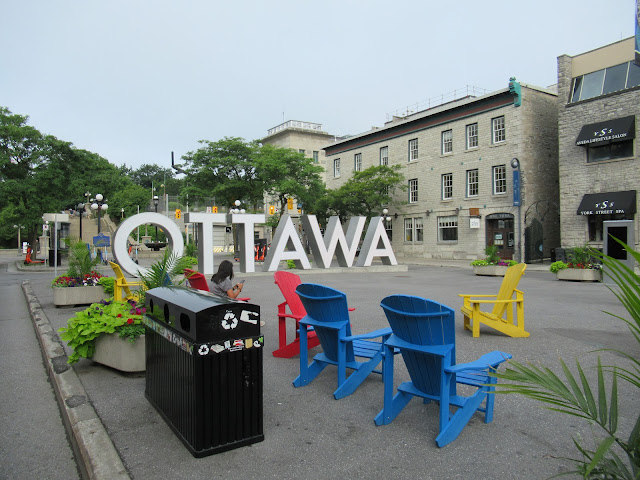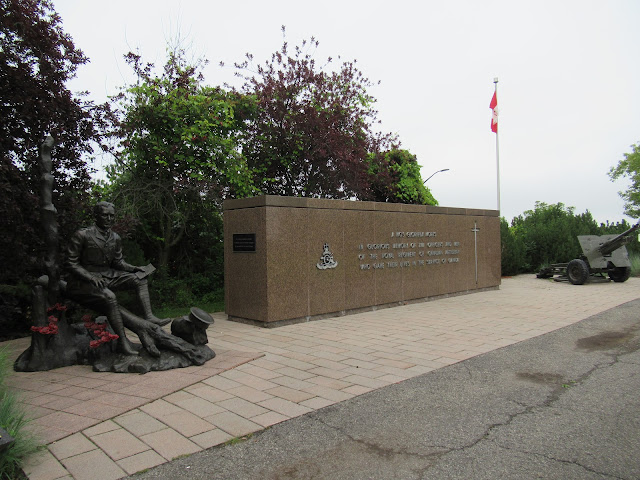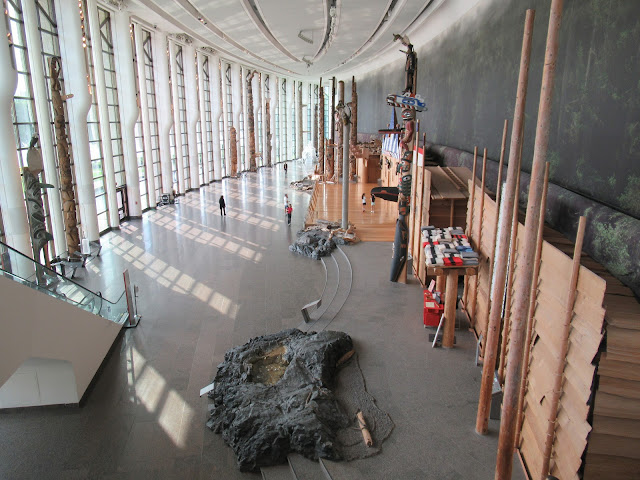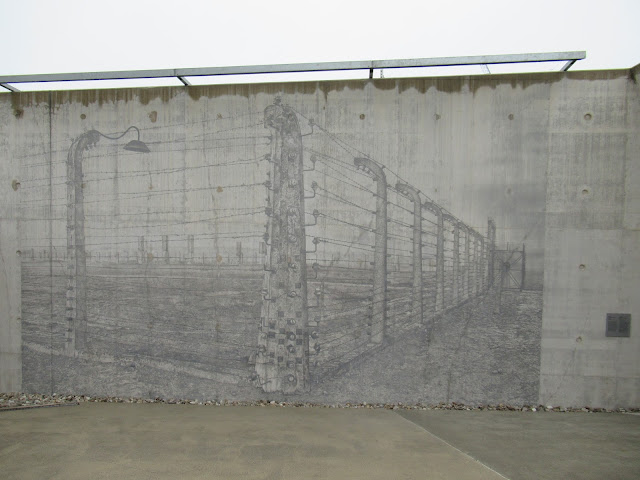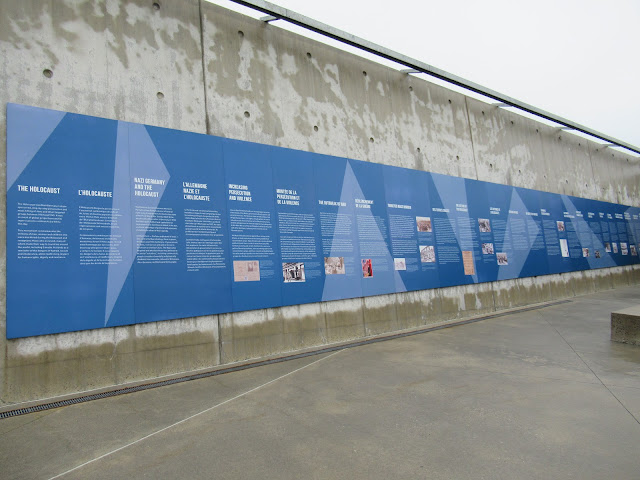That's the slogan on large posters in the MacDonald-Cartier airport, aka Ottawa International Airport, and it certainly applies. There are so many museums and monuments here that it would have been impossible to see them all in the week-long trip I took at the end of July this year. So I made my choices, and here they are.
Just off Sussex Drive is the 3D "OTTAWA" sign; these are a pretty common sight in many towns and cities these days.
Day One
Flying in via Porter Airlines from Billy Bishop airport, I arrived on time, and took OC Transpo, Ottawa's public transit, from the airport. Two bus routes got me to about a block away from my hotel. Nice!
Part of these bus routes run on three levels, in dedicated lanes separate from the streets and highways. Once you get farther into downtown, of course, they wend their way through local neighbourhoods, which gives you a chance to see the real city.
After checking in to a very nice air-conditioned hotel room, I decided to strike out and see a few things, starting with Parliament Hill. It's a bit of a construction site these days, undergoing much-needed restoration. Here's the centre block, where the House of Commons usually sits, though it's been moved elsewhere during renovations. In the foreground is the Centennial Flame, built in 1967 for Canada's 100th birthday.
Here's the west block, containing offices for parliamentarians, and other official rooms, and built in Victorian High Gothic style. Renovations have been completed on this building.
And, the east block, also having undergone renovations recently, houses offices and meeting spaces for parliamentarians and senators. It's in the same architectural style as the west block.
To the east of the centre block are some monuments to events and personalities in our history. I was lucky enough to catch an outdoor guided tour around the buildings while there, and the next series of pics will be from that.
This is the bronze monument for the War of 1812, featuring soldiers, guides and militia.
The other side shows officers, and probably heroine Laura Secord. You can see the guide and the small tour group at right.
The bronze effigy of Sir Wilfrid Laurier, our seventh Prime Minister, who led the country into the 20th Century, famously declaring it "belongs to Canada."
The view from Parliament Hill across the Ottawa River is really great. There's the Alexandra Bridge, and to its left, the Canadian Museum of History, which I'd explore on Wednesday.
You can see it's hazy, and the whole week was hot and humid like this. I was glad to be able to spend most of it in air-conditioned places!
This rotunda-type building is the Library of Parliament. It's actually the only intact part of the original centre block, after a 1916 fire ravaged most of it. The guide told us that the heavy, large metal doors that led to the library were closed just in time to stop the fire from spreading there!
And, no tour of Ottawa would be complete without a statue of our first (and third!) Prime Minister, Sir John A. MacDonald. Like him or not, you can't deny his immense contribution to the country's history.
And, the Peace Tower stands at the centre of it all.
On a personal note, I was up in that tower during a class trip in eighth grade. From there, we saw then-Prime Minister, Pierre Trudeau, entering a limousine!
And, around again to the front of the centre block, there was an opening in the fencing just large enough to get a pic of "the hole" where there will be construction for some years to come. The guide told us that they're planning a welcome centre just to the west of centre block, which will lead to underground passages to all the blocks. She said work on all the necessary renovations is anticipated to take most of 10 years. Wow!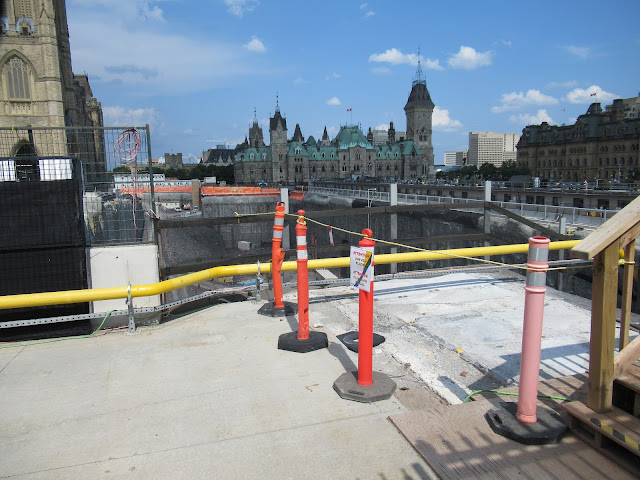
Standing on guard...
And, hey - gargoyles!
Right alongside Parliament Hill is the beginning of the Rideau Canal, constructed in the mid-1800s as an alternative supply/personnel route, in case of an American incursion via the Ottawa River. The canal goes all the way to Kingston, and is now a pleasure route for boaters!
From the opposite end, you may be able to see that there are eight levels of locks, leading up to the main one to the canal that goes through the city. The locks are still hand-operated, largely by high school or college students as a summer job.
At the top, you can see the Chateau Laurier Hotel - not where I stayed, needless to say!
I poked around the Rideau shopping centre for a bit, and explored Byward Market, where I bought a much-needed broad-brimmed hat.
Coming back via Elgin St., I had to get a picture of the stirring War Memorial. There was a family there taking pictures, and the little daughter posed at the side of the monument, giving a salute, which I found quite sweet and touching.
That was Day One. I was glad to get off my feet, and relax - and shower! - in the hotel room.
Day Two
I woke up about 7:30, and got breakfast at a nearby Starbucks. Then, it was up Elgin St., and on to Sussex Drive to see the Notre Dame Basilica, and explore the National Art Gallery.
Turned out I was too early, as the Basilica didn't open until 9 am, but I got some exterior shots in the morning sun, anyway. The building isn't fancy on the outside, but the striking feature is the tin along the sides and on the twin steeples, apparently a tradition in French-Canadian church architecture.
From across the street, a front view. The Virgin and Child statue on the peak of the roof is in wood, by the Italian sculptor Cardona.
As it was too early to go into the Basilica, I decided to trek up Sussex Drive, with the vague aim of perhaps seeing the Prime Minister's residence.
On the way was the Royal Canadian Mint building. I had been thinking of taking a tour there, but decided against it - it's kind of a long story.
There were many embassies, parks and monuments along Sussex Drive, but I had to get a pic of this tribute to Lt.-Col. John McCrae, well-known author of
In Flanders Fields. At left, a statue of McCrae, centre, a monument "to our glorious dead," and at right, a WWI artillery gun.
Moving farther east, here was the Rideau River, another river that flows into the Ottawa, only over this dam and falls. The MacDonald-Cartier bridge is in the distance.
I had to get a shot of these ducks, just casually paddling around right on the precipice of the falls, presumably picking and eating aquatic plants. They would quack to each other occasionally, and it amused me to think of them having a conversation, like, "'Sup." "Eh, not much, nose to the grindstone, y'know." "I hear ya, bruh."
Continuing along Sussex Drive, and having to change sides of the street a few times due to all the construction going on, finally made it to number 24. Unfortunately, something I didn't know was that the Prime Minister's residence is in behind a large copse of evergreen trees, and of course, bristling with security devices. 24 Sussex is also facing an uncertain future. A guide at Parliament Hill confirmed what I'd heard, that they're still on the fence about refurbishing the building, or demolishing it and putting up a new one entirely. It's in bad shape, and has been neglected for years.
At the west entrance, though, and in a triangular intersection in the street, there was this striking equestrian statue of the late Queen Elizabeth II!
So, after retracing my steps, I got into the Notre Dame Basilica. As you'll see, it's much nicer on the inside, starting with the entrance. Embossed floral motifs and triangular panels in blue and red make it really stand out.
Most of the columns inside were faux-marble, and hollow. This one had a serpentine pattern, and a beautiful golden maple leaf motif.
The nave is really breathtaking, with three levels of arches, and a blue ceiling with gold-leaf stars that shine. It was restored in 1999, and kept the original neo-Gothic ribbed vaulting from 1872.
The west window above the organ loft is also quite beautiful, and also newer, dating from the mid-20th century.
The apse is also amazing, with the altarpiece, statuary and stained glass.
The altarpiece is carved in wood, and stands 52 feet!
These gorgeous choir stalls are made from mahogany, carved in 16th-century Gothic style.
Many lovely stained-glass windows to choose from, but I especially liked this one of the Annunciation. I'm always drawn to depictions of this Biblical story, for some reason.
Another shot of the ceiling, with the blue, red and gold colour scheme and intricate ornamentation.
There are two stunningly ornate altars on either side of the apse. This one is the Immaculate Conception, by Louis-Philippe Hebert and others. The Mary statue at centre is covered in gold.
Another beautiful - though also no doubt contemporary - stained-glass window, to the right of the altar. They didn't show up in the picture of the altar, so I thought I'd highlight one of them at least.
This is the other altar, described as "flamboyant" even in the guide, which is certainly the case. It's another one by Hebert and others, depicting the concept of the Sacred Heart.
And, finally, I wanted to get a shot of some of the marvelous pipes in the organ loft. The organ is an 1892 Freres Casavant (a brand familiar to many Toronto church-goers, I imagine), and was updated in 1998. There are a total of 4.700 pipes in the church altogether! Wish I could have heard it played...
Then, it was literally across the street, to the National Gallery of Canada. As you can see, the building is quite new, and really stands out as an artwork of its own.
From the entrance, you proceed along this amazing glass corridor to the entrance to the exhibits. There are also artworks along these walls - and even overhead!
The main area is the Scotiabank Great Hall, from where you go into the different galleries.
This is truly a national art gallery, holding every kind of art you can think of. The European Gallery goes from Flemish masters to Francis Bacon, and the Contemporary and Canadian galleries have Abstract Expressionist and, of course, Group of Seven pieces.
And not least, there is a significant gallery of Indigenous art that covers many centuries, as well as modern paintings and sculpture.
After the whole day in this great gallery, it was a rather weary trudge back to the hotel. But I did find to my delight, the Deacon Brodies pub, about a block away, which had a Happy Hour special every day. You could get a pint of beer for $5 - $7, and a small meal for $5. Perfect after the expensive lunch at the museum!
Day Three
Finding a cheaper, but equally good, alternative to Starbucks just a few blocks down Elgin St., I breakfasted at the Bridgehead Coffee shop the rest of the week.
Then, it was the longest walk of the week, into the Province of Quebec, actually, to the Canadian Museum of History.
Striking out across the Alexandra Bridge, you can see the museum in the distance, along Rue Laurier in the city of Gatineau.
The cycle and walking path only ran along the west side of the bridge, but was a very comfortable way to get across.
Once again arriving before the building opened, I got a few shots of the exterior. As you'll see, its design is rounded and curved, perhaps a reflection of the Ottawa River where it lies near.
Even the terraces, stairways and patios are curvilinear. At top is a wonderful lookout platform.
The only angles on the outside of the building are the tops and bottoms of walls. Even support pillars here are all rounds and curves.
Higher up and farther back is a better view of some of the greenery and grounds.
The view of the entire Alexandra Bridge from the lookout platform.
And the final exterior shot, a view from above of the remarkable Zen garden, based on Japanese raked-gravel gardens. For fun, I hopped along the stone path near top of pic, and came around to the paving-stone part at bottom!
Then, it was inside. The first thing you see will take your breath away; the Grand Hall, the beginning of several First Peoples' exhibits. There are about a dozen or so stunning totem poles, some about 40 feet high, to marvel at. On the right are reconstructed Indigenous habitations, containing artifacts from many centuries - millennia, actually - of history.
I don't usually take pictures of artworks, but this one was pretty special - Alex Janvier's
Morning Star - Gambeh Then' was so striking and beautiful, I had to make an exception. It's on the ceiling, above, yes, curved staircases leading to the exhibits.
There was a lot to see in this place.
Much of the gallery is devoted to the First Nations peoples, and rightly so. There was a wall-size map of North America from before European times, and it was quite fascinating to think of the continent as having no borders.
But the rest of our history is presented here also, from Colonial times, the opening up of the west of the country, Confederation, the transcontinental railway, the wars, the Centennial (Bobby Gimby's "Ca-na-da" song plays on a loop at one point), the October Crisis of 1970 (with a video of Pierre Trudeau's "just watch me" confrontation with the press), the patriation of the Constitution, and more.
We have an amazing history.
After another full day, it was back across the Alexandra bridge, and this view west along the Ottawa.
At a lookout point on the Ontario side, another view of Parliament Hill, and, at left, a good view of all eight levels of the locks at the Rideau Canal. Still hot and hazy.
Then, another Happy Hour treat at Deacon Brodies, and back to the hotel.
Day Four
It was a cloudy, drizzly morning as I set out for the Canadian War Museum. I'd thought to buy an umbrella previously, and was glad to have it.
A little tricky to find your way there on foot! But something unexpected was nearby, just to the east of the museum - the stark, angular concrete National Holocaust Monument. There was no admission or gate, you could just freely walk through it.
There were a few pieces like this one, drawn or etched directly onto the concrete walls. This one is a depiction of a barbed-wire, electrified fence around one of the concentration camps.
Here is a timeline of the Holocaust - not just Nazi Germany's role, but a reminder that European Jewish refugees hoping to escape the terror were turned back by both Canada and the U.S.
This was a very sobering reminder, and on an appropriately dreary day, that ignorance and hatred still survive to this day. Let us never forget. Let us never repeat.
So, it was off to the War Museum. There was construction at the west face of the building, and I had to tramp all the way around the LeBreton Flats Park to get to the main entrance, in the distance here.
The building from here looked kind of bunker-ish!
Another very "compleat" museum, with all of Canada's military history covered in detail. Each gallery explored a different era, starting with Colonial expansion and conflict with the Indigenous population. Next was the Boer and First World Wars, where new horrors were met. There's a reconstruction of a WWI trench, with sandbags, sounds of gun and shell fire, even a makeshift periscope that you could look into and see distant explosions. Also, a walk-through depiction of Passchendaele that even featured a half-buried corpse! There was also a tribute to pilots, with a replica of Billy Bishop's plane.
Another gallery showed WWII, with one of Hitler's Mercedes-Benz limousines on display, among many other artifacts.
The Cold War followed, with a mock-up of a dugout from the Korean War, and onto various spy and intelligence-gathering activities.
Finally, the modern era, and Canada's important role in peacekeeping and defence around the world, with some sober reminders of things like IEDs.
Perhaps the most striking was the LeBreton Gallery, a huge space filled with actual vehicles and equipment of war - even a jet fighter. There were a couple of modern-era tanks that were open at the back, so you could see what it was like inside them.
Finally, here's a couple of views of the west facade of the building (that you couldn't get to due to the construction), again, a striking modern design. Yes, by this time, the sky had cleared, and it was brilliantly sunny.
So it was another full day here, then a walk back to Deacon Brodies for Happy Hour dinner, and back to the hotel.
Day Five
I was supposed to check out of the hotel by 1 pm, so I had the morning to do a little more walking. I'd briefly been on the trail alongside the Rideau Canal, and as it was only a short distance from the hotel, I figured I'd take the opportunity to explore.
It was a lovely walk in the morning, but you wanted to be on the shady side of the path.
I got up as far as Major's Hill Park for a last look at the Ottawa River, then heard some kind of yelling and what sounded like gunshots! It didn't sound like something random, and when I heard bagpipes, it occurred to me that maybe it was something ceremonial. Sure enough, it was the installation of the guards at the War Memorial & Tomb of the Unknown Soldier. The commander would bark out orders in English and French, and the guards would crisply respond.
The guards stand at those sentry posts in shifts throughout the day, with short marches once in a while. I didn't envy their job in this weather!
While in Major's Hill Park, I couldn't resist another shot of Notre Dame, especially striking in the bright morning sun.
Then, it was back south along the Rideau Canal to pack and leave.
I got the same bus routes back to the airport in plenty of time for the flight. Unfortunately, there was a hellacious storm while we were waiting. It was a sight to see there at the airport.
Also unfortunately, the flight was delayed by three hours, and necessitated the purchase of super-expensive airport food, and a book (the most recent Jack Reacher novel, which was at least diverting!) Instead of arriving home about 5 pm, it was an 8 pm arrival at Billy Bishop.
Oh well, no regrets. I sure got in a lot of walking, and my knees made sure I didn't forget it!
It was a fine trip, lots of memories, some souvenirs, and a reminder how much I enjoy traveling.















